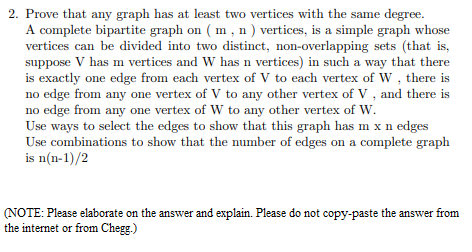Prove that any graph has at least two vertices with the same degree. A complete bipartite graph on ( m , n ) vertices, is a simple graph whose vertices can be divided into two distinct, non-overlapping sets (that is, suppose V has m vertices and W has n vertices) in such a way that there is exactly one edge from each vertex of V to each vertex of W , there is no edge from any one vertex of V to any other vertex of V , and there is no edge from any one vertex of W to any other vertex of W. Use ways to select the edges to show that this graph has m x n edges Use combinations to show that the number of edges on a complete graph is n(n-1)/2
Prove that any graph has at least two vertices with the same degree. A complete bipartite graph on ( m , n ) vertices, is a simple graph whose vertices can be divided into two distinct, non-overlapping sets (that is, suppose V has m vertices and W has n vertices) in such a way that there is exactly one edge from each vertex of V to each vertex of W , there is no edge from any one vertex of V to any other vertex of V , and there is no edge from any one vertex of W to any other vertex of W. Use ways to select the edges to show that this graph has m x n edges Use combinations to show that the number of edges on a complete graph is n(n-1)/2
Linear Algebra: A Modern Introduction
4th Edition
ISBN:9781285463247
Author:David Poole
Publisher:David Poole
Chapter3: Matrices
Section3.7: Applications
Problem 80EQ
Related questions
Question

Transcribed Image Text:2. Prove that any graph has at least two vertices with the same degree.
A complete bipartite graph on ( m, n ) vertices, is a simple graph whose
vertices can be divided into two distinct, non-overlapping sets (that is,
suppose V has m vertices and W has n vertices) in such a way that there
is exactly one edge from each vertex of V to each vertex of W, there is
no edge from any one vertex of V to any other vertex of V , and there is
no edge from any one vertex of w to any other vertex of W.
Use ways to select the edges to show that this graph has m x n edges
Use combinations to show that the number of edges on a complete graph
is n(n-1)/2
(NOTE: Please elaborate on the answer and explain. Please do not copy-paste the answer from
the internet or from Chegg.)
Expert Solution
This question has been solved!
Explore an expertly crafted, step-by-step solution for a thorough understanding of key concepts.
Step by step
Solved in 4 steps

Recommended textbooks for you

Linear Algebra: A Modern Introduction
Algebra
ISBN:
9781285463247
Author:
David Poole
Publisher:
Cengage Learning

Linear Algebra: A Modern Introduction
Algebra
ISBN:
9781285463247
Author:
David Poole
Publisher:
Cengage Learning